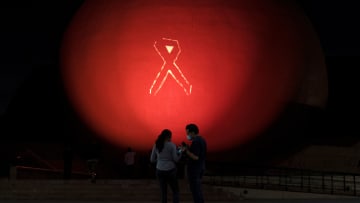دبي، الإمارات العربية المتحدة (CNN) -- هل أنتِ على دراية بما عليكِ البحث عنه للكشف المبكر عن إصابتك بسرطان الثدي؟ إذا كانت معلوماتك محصورة بإيجاد كتلة، فأنت تفتقدين إلى بعض الدلائل الأخرى المهمة.
وأظهر استطلاع جديد لآراء المستهلكين بتكليف من مركز السرطان الشامل بجامعة ولاية أوهايو، ومستشفى "أرثور ج. جايمس للأمراض السرطانية" ومعهد "ريتشارد ج. سولوف للأبحاث" (OSUCCC)، أنّه في حين أنّ 93% من البالغين في الولايات المتحدة يعتبرون أنّ وجود كتلة يدلّ على الإصابة بسرطان الثدي، فإن أقل من النصف يمكنهم التعرف إلى غالبية العلامات الأخرى.
وأوضحت الدكتورة أشلي باريزر، طبيبة أورام الثدي الطبي ومديرة خدمات النجاة من سرطان الثدي في "OSUCCC" أنّ العلامات الأخرى التي تم التعرف إليها من قبل أقل من نصف المشاركين في الاستطلاع، تشمل الحلمة المنكمشة، أو المقلوبة، أو المتجهة إلى الأسفل، وتجعد الثدي الذي يظهر عند رفع ذراعيكِ، وفقدان الإحساس في جزء من الثدي، وسماكة الجلد والحلمة.
وأظهر الاستطلاع أن 31% فقط من أكثر من 1000 شخص أكملوا الاستطلاع، حدّدوا الحلمة المقلوبة كعلامة على سرطان الثدي، في حين حدّدت نسبة 39% التجعّد، و41% فقدان الإحساس، و45% سماكة الجلد، 51% وجود إفرازات.
وأفادت باريزر في بيان أن نقص المعرفة يثير القلق لأن غالبية سرطانات الثدي لا يمكن اكتشافها من خلال وجود كتلة، يمكن اكتشافها عن طريق اللمس.
وأضافت: "نريد أن يكون لدى النساء القدرة على معرفة ما يصيب أجسادهن واكتشاف ما هو طبيعي بالنسبة إليهنّ". وتابعت أنّ "العديد من التغيرات في الثدي هي نتيجة للشيخوخة والولادة. ومع ذلك، يمكن أن يظهر سرطان الثدي بطرق عدة".
ولفتت إلى أنه "من المهم أن يشعر الناس بالأمان لمعالجة هذه المخاوف في الوقت المناسب مع طبيبهم. لقد قطعنا خطوات كبيرة لاكتشاف سرطان الثدي في مراحل مبكرة وأكثر قابلية للعلاج".
وبحسب جمعية السرطان الأمريكية، لا يزال سرطان الثدي الأكثر شيوعًا بين النساء بعد سرطان الجلد، مع توقع ما يقل قليلاً عن 300 ألف حالة جديدة، و43 ألف حالة وفاة، في عام 2023.
وأشارت باريزر إلى أنه "رغم أننا نخطو خطوات كبيرة فيما يتعلق بالكشف والعلاج، إلا أننا للأسف نعيش في عالم لا يزال فيه سرطان الثدي يشكل مصدر قلق خطير للناس".
لمَ الكشف المبكر؟
ويثير نقص المعرفة قلق الدكتور أوتيس براولي، أستاذ بلومبرغ المتميّز لعلم الأورام والأوبئة في جامعة "جونز هوبكنز"، غير المشارك في الاستطلاع.
وأعرب عن ذلك بقوله أنّ "سرطانات الثدي الوحيدة التي يتم علاجها هي تلك المكتشفة باكرا".
وأوضحت باريزر أن فحص تصوير الثدي بالأشعة السينية مهم لاكتشاف سرطان الثدي في مراحله المبكرة والأكثر قابلية للعلاج. وأضاف براولي أنه في غالبية الأحيان، يتم اكتشاف هذه الحالات من خلال الأعراض المذكورة في الاستطلاع.
وخلصت باريزر إلى أن هذا هو السبب وراء حاجة النساء وأطبائهنّ للتعرّف إلى ما هو طبيعي بالنسبة لثديهنّ.
وتابعت أن "أفضل طريقة بالنسبة لنا لاكتشاف سرطان الثدي في وقت مبكر هي أن تقوم النساء بالتوجه إلى الطبيب المختص بمجرد ملاحظة التغيير، ومن الأفضل حتى قبل أن يرين التغيير".
ولفتت برازير إلى أنه عندما يتعلق الأمر بسرطان الثدي، يحتاج الرجال أيضًا إلى هذا التمكين.
وأوضحت أنه "رغم أنّ المرض أقل شيوعًا لدى الرجال، إلا أن 1% من حالات سرطان الثدي تصيب الرجال. وتظهر هذه السرطانات عادةً كتغيرات في الحلمة، لذلك من المهم أيضًا أن يشعر الرجال بالقدرة على طلب الرعاية الطبية للأعراض المثيرة للقلق، خصوصًا إذا كان لديهم تاريخ عائلي قوي للإصابة بسرطان الثدي".



